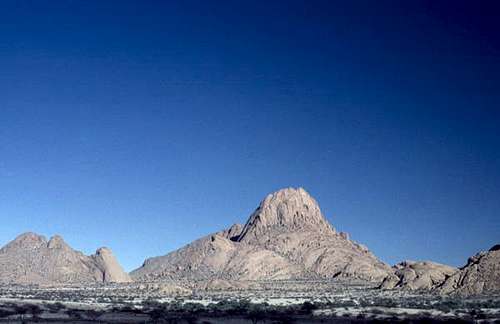|
|
Mountain/Rock |
|---|---|
|
|
21.85°S / 15.15000°E |
|
|
5846 ft / 1782 m |
|
|
Overview
Spitzkoppe is a remarkable granite peak that rises 700 m above its surrounding, this fact makes the mountain also known as the "Matterhorn of Namibia". Next to the Spitzkoppe is the "Little Spitzkoppe" with a height of 1584m. Although Spitzkoppe is not the highest mountain in Namibia, due to its characteristic appearance it is the most famous one. Since Spitzkoppe is situated in an endless, dry plain, the island of mountains can be seen from far away.
The granite massif of Spitzkoppe, which is part of the Erongo Mountains, was created by the collapse of a gigantic volcano more than 100 million years ago and the subsequent erosion, which exposed the granite. The granite is very coarse with a lot of sharp crystalline inclusions.
Climbing History
It is possible that the main peak was summited as early as 1904, when a soldier of the Royal Schutzruppe supposedly soloed the peak and made a fire on the summit. However, he never returned and also his body or any other proof of his conquest was never found.
Further attempts were rumoured in the 1920’s and 30’s, but it was not until 1940 that climbers truly laid siege to the peak. First was a team of Cape climbers led by le Roux. They attempted the peak from the Southwest ridge, gaining its crest but being held back near the summit by a plug of insurmountable granite (today known as the 'gendarme').
Next limbers O’Neil, Shipley and Schaff attempted a route up the northern extremes of the peak, after having failed on the Southwest ridge. They accessed a gully (today known as the ‘scramble’), but were out of time to attempt the final faces. They returned on the next morning, but were again stopped by an insurmountable belt of granite. Frustrated, they decided to chisel holds to the summit, but within a week they had given up.
A few months later Hans and Else Wong and Jannie de V. Graaf arrived and they soon stood below the chiselled steps. More chiselling continued, and finally at noon, in November of 1946 they reached the summit.
But certainly the Spitzkoppe story would not be complete without mention to one particular climber, E Haber who, together with A Lombard, C Ward and Holding completed the first ascent of the southwest Wall, starting in 1979 and only finishing the route in 1982 - the first of the big wall climbs on the peak.
Since then, the Spitzkoppe region remained popular for Namibian and foreign climbers, and the region is also great for bouldering. There are about 100 sport-climbing routes from grade 15 to about 30 and 50 trad routes from grade 12 to 27 on granite. Trad can be climbed from one- to multi pitch routes including "big wall" climbing on 450m high walls.
Detailed route descriptions can be found in the climbing guide to the area:
Haber, Eckhardt: Spitzkoppe and Pontoks - Namibia, a Climbers Guide. Blue Mountain Publishers, Cape Town, 2nd edition 2001. ISBN 0-620-27337-2
The book is available in bookshops in Windhoek.
Getting There
Spitzkoppe lies between the bigger towns Swakopmund and Usakos. Turnoffs from the highway B2 are marked by signs. From B2 it is approx. 20 km to the entrance of the Spitzkoppe conservancy.
Guided tours and climbing expeditions are offered by different tour operators throughout Namibia.
Red Tape
Access is not restricted, but you have to pay a fee to enter the conservancy around the mountain massif.
When To Climb
Climbing is basically possible all year round, however winter months (June, July, August) are recommended if you want to do real climbing. In summer, the rocks can get very hot, and one may even burn ones hands.Camping
Some years ago there was a robbery at Spitzkoppe during which a tourist came to death. As a conseqence, the local Damara community restricted the formerly free access to Spitzkoppe. The area around the mountain massif is now a conservancy and is fenced off. Visitors pay an entrance fee of 20 Rand per person, the vehicle costs 10 Rand.
A restcamp was established with a guarded campground and plain bungalows with 2 or 3 beds. The bungalows cost 100 N$ per person (including breakfast). A camping spot costs 20 N$ per person. There is also a bar and a curio shop.
Mountain Conditions
Usually no severe weather is to be expected, however in summer months the heat (above 40°C) should not be underestimated. Also, the granite is very coarse with some sharp crystalline inclusions, so climbing with gloves is recommended.
<
Miscellaneous Info
The region around Spitzkoppe has a lot of interesting wildlife. There are some strange plants to see, which are specially adapted to the drought in summer.









